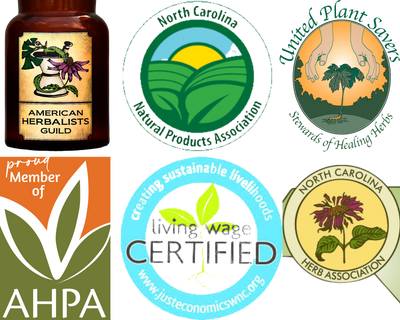Herbs in the Birth Plan
My 40th week of pregnancy landed me in late July with a ‘guess’ date of July 22nd. But I had a sneaking suspicion that my son would push the envelope and wait until it was leo season, my husband and I both being leos ourselves. He was born at 41+6, on August 4th, during the hottest summer on record here in the Appalachians. It was all I could do to stay semi-hydrated during the three days of labor, sweat, projectile vomiting, and trying not to pee in the birthing tub we’d set up on our front porch of our 1914 cabin. Watermelon chunks and coconut water were my only allies in the whole world, I felt.
As an herbalist, my ‘nesting’ time had been characterized by all sorts of miscellaneous tasks that get pushed to the bottom of a herbal maker's list: brew
nettle infusions for drinking immediately postpartum, make freezer space for placenta, eat dates, get
yarrow ready for the cord cutting, do one more
red clover harvest to dry the blossom for infusion before baby comes. All the crunchy mom stuff, and then some. I couldn’t bend over anymore but I sure as sugar could sit in a field of flowers and pick.
Our whole house was plastered with lists on every wall, lists I’d made for the midwives of what herb I wanted them to use for what delivery complication, lists for myself reminding me of what I wanted my birth to look like, lists for the doula of what herbs I wanted to use directly after birth. Herbs were the backbone of my birth plan. And while there’s plenty they can’t do, there are many more situations during labor and birth during which herbs can play a major role in supporting a healthy mama and healthy baby.
While I’m not going to post my whole birth story here (like I said, it was THREE days of labor), I will share with y’all a few of my favorite herbs to have on hand to support birth, whether medicated or not, at home or in a hospital. I recommend including these herbal extracts as part of your birth kit, and letting your birth team know where they are.
If you made them yourself, make sure they are well labeled with the dosage on the bottle. If you’re going to order them, make sure you order fresh extracts made with organic or wildcrafted herbs to ensure you’re getting
the strongest potency.
Many of the herbs on the market are adulterated with other plants or other substances entirely. Many of the herbal products labeled as black cohosh, for example, are not just black cohosh, but other lookalike roots such as the toxic bugbane, a powerful plant that you do not want to mess around with. Moral of the story: choose herbal extracts from small companies or individuals who know their stuff, do their own growing/wildcrafting, and earn your trust.
Herbs to Support Labor
While no one thing - not even the spiciest of hot peppers, the bounciest of birth balls, or a crazy strenuous mountaintop hike, trust me - will kickstart labor until baby is really ready, one tried-and-true herbal formula that has had great success in gently encouraging the labor process involves
black cohosh and ginger. Ask your herb-literate midwife or doula about this traditional formula or check out the resources below to learn more.
St. John’s wort, an antispasmodic and anodyne, can be used during early labor to ease some of the spasms and discomfort of contractions without slowing down the labor process. Likewise,
skullcap can be used a very similar way but with more of an effect on the mental state of the laboring mother than on the physical body. Skullcap acts on the nervous system to help soothe tension and smooth over stress and anxiety, which goes a long way towards encouraging a productive, efficient rhythm of contractions.
Motherwort and
lobelia offered to a regularly laboring mom, usually in early labor, seem to have a shared goal of relaxing the pelvic floor, easing rigidity, and somewhat allaying the pressure and discomfort of contractions while allowing labor to progress normally.
Double whammy ginger and
ginseng extracts make a terrific combo for promoting sustained strength and stamina during the long and fatiguing hours of labor. Ginger helps to improve normal circulation while ginseng provides a rainbow of gifts, but what’s probably the most important to the laboring mother is that of energy and endurance. Think of these two as herbal cheerleaders to get you through the whirlwind vortex of birth.
Liferoot in very small doses is sometimes used by midwives when there is a lull or break in contractions. It has been found to have a quickening and strengthening quality to it that may help re-establish a stalled labor.
Herbs Used During the Birth
Yarrow is known as a first-aid kit in one plant. In birth and the postpartum period, its quality as a well-established styptic or blood-stopper is extremely valuable. I used it on my baby’s cord stump to help the drying and recuperation process and ensure that tissue remained healthy. During the time immediately post-delivery, a combination of yarrow and motherwort is known to promote the uterus's closing and begin the process of normalizing again.
Yellow dock is another one of my top immediate postpartum go-tos. Its affinity for iron and ability to restore and nourish the blood is critical after birth and potential depletion and blood loss. Mix the tincture with molasses to make a syrup for an extra blood boost! It may also help ease occasional constipation.
Ground ivy has been used by many midwives as a mover of the placenta. Used in the right dosage (see resources below for more on this), it may support in bringing a stubborn placenta down and encouraging the emptying and clamping down of the uterus.
Comfrey oil is an essential to have at a birth, because whatever oil you don’t use up during the crowning stage will be used as a sore nipple rub later on, or even a diaper area soother. A midwife or doula can have comfrey oil on hand to offer the birthing mother some extra lubrication and elasticity during crowning. Comfrey is also a supreme herb for encouraging vaginal health post-birth because of its unique ability to promote skin cell abundance and overall cell integrity.
After the birth of my son, I downed my weight in nettle infusions over the next three months, drinking up to a gallon a day to replenish my liquid resources: blood and milk, both. My husband scurried around the kitchen, bringing me dried apricots, jugs of nettle infusion, more jugs of
oatstraw infusion, and yes, placenta smoothies, to bring me back to life after a wildly intense first birth experience. Without my faithful yellow dock and yarrow, I would not have been able to make the same transition into motherhood that I did.
Herbal Resources for Pregnancy and Birth
I’d be lost without my vast collection of handy dandy pregnancy and birth resources from MDs, NDs, and others in the natural health realm who I trust. This short list doesn't even scratch the surface of the myriad incredible birthing resources out there to prepare moms for all sorts of birth scenarios from Pam England's Birthing from Within to the Birth Hour podcast to Sarah Buckley's Gentle Birth, Gentle Mothering to Ina May Gaskin's Spiritual Midwifery and, of course, the incredible documentary film "The Business of Being Born".
Here are a few of my absolute favorite resources for the healthy and reliable use of herbs during pregnancy, labor, and birth.
-
The Nursing Mother’s Herbal - this go-to manual is quite thorough and I’ve come to rely on it heavily during the 3.5 years of nursing my child thus far. It issues each herb a clear safety rating, and is also appropriate during pregnancy.
-
Conceiving Healthy Babies: An Herbal Guide to Support Preconception, Pregnancy, and Lactation - whether you’re TTC (trying to conceive), pregnant, or nursing, Dawn Combs’ is a lovely person and has a lovely book full of herbal advice on everything from fertility to kombucha to milk production.
-
The Natural Pregnancy Book - Dr. Aviva Romm is one of my heroines, a beloved teacher of mine, and the author of basically the ultimate guide on herbs during pregnancy. She includes rituals for celebrating pregnancy, lots of nutritional strategies, and advice on common concerns during pregnancy such as preeclampsia, stretch marks, UTIs, fatigue, and morning sickness.
List of Herbs to Keep on Hand
I mentioned more than a dozen herbs above, and whether you’re familiar with them or not, it’s a lot to take in. To make it easier for you, I made a list of all the herbs I had on hand during my pregnancy.
Of course, I am not a licensed medical professional and am very limited in what I can say about any herb. Do your own research, come back to us and let me know what you find!
Disclaimer
The Food and Drug Administration has not evaluated any health related statements that may appear on this site. The products presented on this site are not intended to diagnose, treat, cure or prevent any disease.
THE INFORMATION CONTAINED ON THIS WEBSITE (WWW.REDMOONHERBS.COM) IS NOT INTENDED NOR IMPLIED TO BE A SUBSTITUTE FOR PROFESSIONAL MEDICAL ADVICE. ALWAYS SEEK THE ADVICE OF YOUR PHYSICIAN OR OTHER QUALIFIED HEALTH PROFESSIONAL PRIOR TO STARTING ANY NEW TREATMENT OR WITH ANY QUESTIONS YOU MAY HAVE REGARDING A MEDICAL CONDITION. NOTHING CONTAINED IN THIS EMAIL OR WEBSITE IS INTENDED TO BE FOR MEDICAL DIAGNOSIS OR TREATMENT.








Comments
Heather at Red Moon Herbs said:
Hi Daniella and thanks for your comment! Congratulations to you. With yarrow, many choose to use as directed on our bottle or as needed to support the blood when postpartum and around the birth time. Yellow dock is a wonderful tonic during the postpartum phase for building the blood back up, and may be used as directed on the bottle. Best of health,
Heather
Daniella said:
Hi!!
I’m on #3 and I’m more prepared to use herbals for flavor, Birth, and recovery this time. How long and what dose did you use your yarrow tincture for? I know it could potentially slow milk production but I bled heavily with my last child and want to plan to use it. I also have some yellow dock ready too, how long did you use that one for??
I appreciate your knowledge and insight!